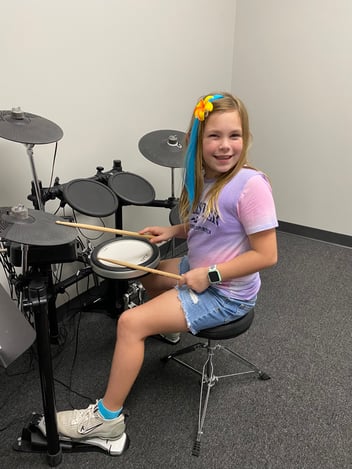Beginners Who Want To Advance To The Next Level Can Use This Intermediate Guitar Tutorial
Do you feel stuck on the same techniques after taking guitar lessons for a while? The initial appeal of mastering chords, riffs, and scales often leads to monotony for some players, which sounds plausible given the circumstances. The brain is programmed to recognize patterns that form habits and preferences. As a result, some people need help approaching a new skill because it proves unpleasant. Whether a computer programmer or a child learning a musical instrument, initial encounters can be challenging. To continue improving your guitar skills, you should shift to your initial mindset and develop a fresh curiosity.
Below you will find a unique intermediate guitar tutorial ideal for beginners who want to improve their skills. In addition to valuable exercises, you'll also find tips and guidelines to help you improve your skills. Let us get started right away.
Your Requirements
Here’s what you will need to kick off;
- You are going to need a guitar. It does not matter if it's acoustic or electric.
- A pen and notepad to write down the lessons of the tutorial
- A way to record your practice. The Garage Band program for Apple gadgets is a good option. You can also use your smartphone.
- Get yourself a metronome. You are about to find out why.
The Complexity Of Transitioning From A Beginner To An Advanced Guitarist
Most guitarists can easily pick up the guitar for a short period, acquire some basic skills, and then stick with those skills without improving them, which is easy OK. However, it pays to put in more effort for players who want to take their skills to the next level.
As mentioned earlier, humans prefer routine and familiarity. No wonder learning to play the guitar must've been a challenge for you unless you belong to the small percentage of those who learn an instrument quickly. Nevertheless, you've developed skills, muscle memory, and reflexes that allow you to play simple techniques on your favorite guitar.
Previously complex scales, melodies, and chords are now a breeze. You wanted to try new things, so your body and brain resigned to being uncomfortable to ensure you were on the right track. But now you're accustomed to your surroundings and have difficulty breaking away. It seems comfortable and encouraging to stay in familiar territory, but if you want to advance to intermediate guitar skills, you need to break new ground and conquer new territory.
Why A Metronome?
Guitarists are, first and foremost, rhythm musicians. It’s worth mentioning that rhythm is the foundation of 99 percent of guitar music. With metronomes, you can practice scales, chords, and riffs. This way, you will improve your technique in about two weeks. To properly improve your skills, it’s crucial to recognize the role of practicing with a metronome.
Activity 1: A Three-Octave Major Scale With Eighth, Sixteenth, And Triplet Variations
Have your metronome ready. To effectively detect rhythm deviations, listen to and track the primary beats. Include alternate plucking in this exercise, i.e., use the fluid motion of your right hand to pluck up and down rather than focusing on a single direction. Set the metronome to a slower tempo at the beginning. A tempo of 60-75 BPM is good.
Begin by playing a full scale with simple quarter notes. For the next section, switch to an eight-note scale, repeating each note once. In the third section, hit each note four times with the 16th notes. To increase the difficulty, add a fourth section and repeat each note three times with eighth notes. You will check your hand's tempo, agility, and precision while demonstrating the basic patterns' differences.
Activity 2: Improvisation In G Minor
Begin by memorizing the basic chord progression in G minor, i.e., Gm-Dm-Adim-Bb. You can then string these together without stopping. Then record the slow chord progression you play at least 10-12 times. There are three minor scales in music, the natural, the melodic, and the harmonic.
Try to memorize the 3-octave harmonic G minor scale by memorizing the correct fingering and practicing it repeatedly. Practice this scale slowly with your metronome. You can then take notes from it to play your recorded chord pattern freely. Decide which note groupings you prefer and why. Create your layer for your improvisation.
Activity 3: Major And Minor Arpeggio Forms
Learning basic arpeggio shapes, especially major and minor, will allow you to compose and play your guitar. Create a starter arpeggio exercise to solidify your understanding. In time with the metronome, start with the major pattern on the second and third frets, then switch to a minor shape without stopping. Then go up a fret and repeat the pattern until you reach the 12th fret.
Activity 4: Chromatic pace exercise
Begin by learning the most straightforward chromatic tempo exercise with a slow metronome. When you return to the beginning note, go up to the twelfth fret. Increase your metronome tempo by five to ten beats per minute, and repeat the exercise. The most important thing is to choose a tempo that is strenuous but still doable for you. Slow down the tempo and increase your skills if the metronome is too fast for you. Even though speed is essential, you should equally be in a position to perform your rhythms comfortably.
Think of improving your skills from beginner to advanced as climbing a mountain. You may have come close to the top but discovered a dead end. So you may have to descend again and find a suitable route that will take you to the top. The Music Academy of Texas enables its students to lead fulfilling, balanced, and productive lives by reaping the benefits of world-class music instruction. We understand that each student has a unique learning curve.
For this reason, we customize lessons for each learner. Want to learn more about our high-quality standards and world-class facilities? Visit our website at https://www.musicacademyoftexas.com/katy-cinco-ranch to learn more about how we can assist you.
Name, Address, and Phone
Music Academy of Texas,
25031 Westheimer Parkway
Katy TX 77494,
(346) 646-5355
Follow Us On Social Media
https://www.instagram.com/musicacademyoftexas/
https://www.facebook.com/MusicAcademyTX



